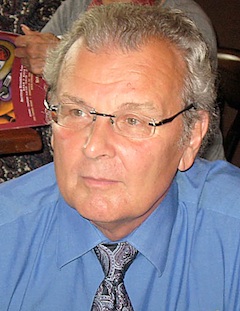This piece was reprinted by OpEd News with permission or license. It may not be reproduced in any form without permission or license from the source.
Once Pythagoras invented and wrote down the mathematical relationship of the sides of a right triangle about 2600 years ago he provided a formula still in use by every carpenter who pounds a nail. When Pasteur invented vaccination two hundred years ago he provided a model that remains in continuous use, largely preventing the epidemics that used to decimate humanity.
When astronauts look down at our birthplace at night, the Great Rift Valley where we discovered how to make fire, probably the most important single discovery in human history, it is still nearly as dark as it was when we started. Though it is populated, the population is sparse. It wasn't and isn't a particularly nice place to live.
But when astronauts look down from the International Space Station at the whole earth at night they can see we've carried that fire to every continent. Great swaths of the planet sparkle like a holiday ornament covered with glitter. We have learned to survive on deserts and on ice caps, in jungles and savannahs, under the ocean and atop Mt. Everest, and most importantly in cities. We have tapped the ancient energy embodied in fossil fuels and uranium, the incessant power of wind, falling water and tides, and more recently direct conversion of sunlight to electricity.
We use that power to bend a harsh environment to our will. To the extent that our wealth permits, we are warm in the winter and cool in the summer. We have adequate food through the seasons. We have medical care at our beck and call, even helicopters when we need transport to a major medical center. And on and on. It's not difficult to make a long list of ways that our intelligence coupled with our tools and our mastery of energy enable us to survive despite Mother Nature's best efforts to take us down.
Of course we haven't entirely tamed the planet. Hurricanes wreak havoc as we were rudely reminded last year in Houston, Puerto Rico and other West Indian islands . Wild fires are devastating as we saw most graphically in California last fall, only to be followed by mud slides that swept houses and cars off mountainsides .
Diseases leap ahead of our vaccines and antibiotics. In the struggle for survival every life form claws its way forward. Bacteria and viruses morph to gain resistance to our drugs -- though that way of thinking makes it seem intentional. Actually, some pathogens experience random change that makes them resistant, and then thrive until we find some new treatment. Flu bugs change annually, and often jump from chickens or pigs to humans, making each year's flu vaccine something of a crap shoot .
Diseases move geographically as well, generally from the tropics toward the poles as the planet warms, but also following our transportation systems. International air travel allows diseases to hopscotch around the globe, and as highways have extended deep into the Amazon rainforest, dengue fever and other lowland maladies have spread far beyond their earlier range.
Hurricanes and wildfires and the spread of diseases are exacerbated by climate change caused by the fires we light in our machines and furnaces, burning ancient sunlight stored in fossil fuels to light and heat our lives today . And while human generated carbon emissions leveled out for a few years, they were up again in 2017, making it apparent that the temporary pause was more due to reduced economic activity following the Great Recession than any serious effort by nations to reduce output.
If you go online and pull up a National Oceanographic and Atmospheric Administration map of the radiation plume from the Fukishima nuclear disaster you see a stark reminder that we don't always get everything right. The radiation plumes have spread all across the Pacific, from Alaska to South America. Meanwhile the increase of carbon dioxide in the atmosphere is increasing the acidity of the oceans which makes it more and more difficult for shellfish to form shells. Tiny crustaceans are at the bottom of most oceanic food chains and the prospects for ocean life become very dim if that process goes too far. All of which is to note that on top of natural threats our technology could be our undoing.
(Note: You can view every article as one long page if you sign up as an Advocate Member, or higher).





